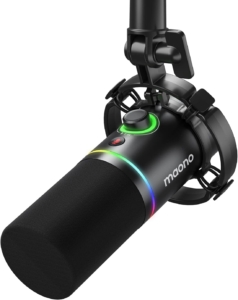Maono PD200X Review: Cheap Price, Cheap Sound?
The sub-$100 vocal microphone market is a crowded one. But the good news is that it’s easy to pick up a great-sounding mic without spending a treble-figure fee. How does the (often discounted) $70 Maono PD200X perform in this category? Let’s take a wee look (and listen!).
Before we dive in, I’ll just mention that Maono sent us the PD200X free for review purposes, and we use affiliate links to help support all of our free content. Rest assured, though—none of this stops us from giving our honest opinions!

Who is the Maono PD200X For?
The Maono PD200X is ideal for any individual intending to produce acoustic signals characterised by modulated air pressure waves, primarily within the frequency range of human phonation, to encode and transmit linguistic information through articulated phonemes and prosody, with the additional objective of capturing and preserving these signals in a digital format through analogue-to-digital conversion techniques.
That is to say, anyone who would like to record themselves talking. I was trying to be funny, but it has really hammered this post’s “readability” score. I hope you appreciated it.
Anyway, you’re an aspiring podcaster or streamer with less than $100 in your wallet, and you want to buy a mic. So what will you get for your dosh?
It’s a Dynamic Mic
The vast majority of mics fall into the “dynamic” or “condenser” category. These terms refer to how they’re built and how they work. There’s no “better” option here, though anecdotally, I find dynamic mics to be more durable and more forgiving of less-than-optimal conditions.
Dynamic mics don’t require Phantom Power, so if you have a wee 48v button on your audio interface, leave it off when you plug in the PD200X.
It Has a Cardioid Polar Pattern
Cardioid is the standard polar pattern for a mic designed to be used by one person.
A microphone’s polar pattern is like the shape of its ears. A polar pattern determines the areas around the mic it’ll focus on to “hear” sound and also the areas it will ignore and reject.
It Works in USB and XLR Form
“Combo” mics that plug in via USB OR XLR used to be pretty rare beasts, but not now. There are a fair few of them on the market, from the ultra-popular Samson Q2U and Shure MV7+ to the PD200X’s Maono cousins, the PD400X and AU-HD300-T.
As a side note, that last name is a doozy, isn’t it?
In any case, if you want to start out with USB (no extra kit needed) and think about adding in an audio interface, mixer, or digital recorder further down the line, then the PD200X is one of many solid options.
It Has On-Board Controls
- A mute button – can you guess what it does?
- A dial that controls both headphone volume (blue) and input gain (green). Press to toggle between the two.
- An RGB button to toggle the colour of the LED light band on the mic. As bells and whistles go, they don’t come much more bells and whistles-ey.
- A 3.5mm headphone jack for active monitoring.
These are only relevant if you’re using the mic in USB form. If you’re running it via XLR into an audio interface, then you’d control everything with its own buttons and dials.
You Can Buy It in White or With a Boom Arm
You’ll need a boom arm to mount your PD200X. If you don’t have one already, you can buy one with the mic for just $10 more, and again, it’s often discounted.

Or, you can spend that extra tenner and buy the PD200X in white. A questionable decision if you don’t own a boom arm, and a luxurious one if you do.
Other Technical Specs of the Maono PD200X
If you liked the paragraph about transmitting linguistic information through articulated phonemes and prosody, then you’ll love this section. Strap in:
- Bit Depth/Sample Rate: 24-bit/48kHz – ensures highly detailed and professional-quality sound recording.
- Frequency Response: 40Hz-16kHz – captures a broad range of sounds from deep bass (40Hz) to high frequencies (16kHz).
- Sensitivity: XLR: -52dBV USB: -10.5dBFS/Pa (Max) – XLR and USB modes offer different levels of signal strength, with USB being more sensitive for direct digital use.
- Max SPL (Sound Pressure Level): >130dB SPL – the mic can handle very loud sounds (over 130dB) without distortion.
How Does the Maono PD200X Sound?
It’d be a real shame if I’d just written all that only to announce that it sounds terrible, and I’ve wasted your time as well as my own.
Fortunately, I think it picks up the voice pretty well and without any reverb, considering it’s just a “normal” room.
My sound sample was recorded via the Focusrite Vocaster (annoyingly, I didn’t have my Maono PS22 to hand at the time). I haven’t applied any cleaning, post-processing, etc, to the file. That’s exactly as it was recorded.
Summary: Maono PD200X Review
For less than $70 (and you’ll often find it on discount), the Maono PD200X is a nice-sounding mic, and a good addition to the “cheap but quality” podcast mics category.
My one single complaint (and it’s a very small one-off thing) is that I wasn’t initially sure if I was toggling the gain or the headphone volume. Toggling between a green light and a blue light told me nothing other than these are two different settings. But I suppose that’s what manuals are for. I’m supposed to read them anyway.
Our Rating: 4.1/5
Ultimately, would I use this mic for podcasting? Without a doubt. It has a thoroughly decent sound for its price point and the flexibility of USB or XLR use.
If you’re a beginner on a budget, then the Maono PD200X is well worth your consideration, though if you’d still like to shop around, check out our main podcast microphones guide for a full range of options!

